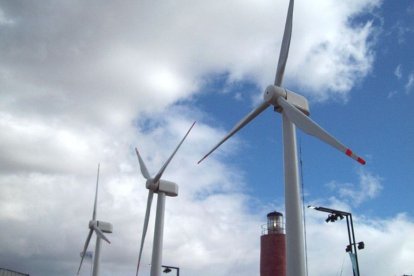Renewable energy companies' failure threatens Joe Biden's green policy
Recent market turmoil, inflation and the refocusing of developers' strategies show that the government will not achieve its green objectives.

Wind energy areas | Wikimedia Commons (Sergio Panei Pitrau)
Offshore wind companies continue to downsize. This has led several companies to delay or cancel projects in various parts of the world, mainly in Europe and the United States. The situation puts the brakes on the Biden administration's goals of generating large amounts of wind power off the country's northeast coast.
Last week, Siemens Energy reported, in a letter sent to its employees and obtained by Reuters, that its Siemens Gamesa wind turbine division plans to eliminate 4,100 jobs, or about 15% of its workforce. The company aims to achieve, by 2024, more than 1.7 gigawatts installed off the coasts of Virginia, Rhode Island and New York.
"Our current situation demands adjustments that go beyond organizational changes. We have to adapt to lower business volumes, reduced activity in non-core markets, and a streamlined portfolio," Jochen Eickholt said in the letter.
Similar is the situation at Shell. In March, the energy company said it sold its 50% stake in SouthCoast Wind Energy, set up to develop wind projects off the coast of Massachusetts, to its joint venture partner Ocean Winds North America for an undisclosed sum, according to Reuters.
Similarly, Reuters recalled that "Earlier this year, European energy firms Equinor (EQNR.OL), opens new tab and BP (BP.L), opens new tab terminated their agreement to sell power to New York state from their proposed Empire Wind 2 offshore wind farm."
The companies' move away from renewable energy projects could affect the green policy pushed by Joe Biden. The White House indicated last year that the Democrat set a goal of deploying 30 gigawatts of offshore wind electricity generation by 2030, enough to power more than 10 million U.S. homes with clean energy.
In that regard, The Telegraph explained that a Vineyard Wind 1 "delivering its intermittent 25-30 per cent of 68 megawatts (MW) to Massachusetts residents in January with the activation of 5 offshore turbines. The South Fork Wind Project was also able to commence first deliveries into New York in March, with 12 turbines capable of generating some proportion of 130 MW."
However, the media outlet also highlighted that those efforts amount to less than 1% of Biden's 30 GW target, with only five and a half years left until 2030.
"Given the wind industry’s insatiable appetite for ever-increasing subsidies and constantly rising utility charges, it’s an open question how many more billions of dollars the federal government will be allowed to print to keep projects alive before the voters start to rebel at the cost," read The Telegraph's report.
Meanwhile, states such as Texas could suffer the consequences of companies focusing all their efforts on renewable energy. Specialist David Blackmon warned in The Telegraph that the state could face blackouts during the summer. That's because in recent testimony before the state Legislature, grid managers from the Electric Reliability Council of Texas (ERCOT) explained that Texas faces up to a 16% chance of rolling blackouts in the height of the August summer heat.
"It’s an inconvenience to which many Texans have grown accustomed in recent years as the state’s grid, overloaded with unpredictable, intermittent wind and solar capacity, has trended increasingly into an unstable state," Blackmon said.
Blackmon recalled that this problem is not new. In the past, during weather emergencies, Texas has experienced power failures. However, Blackmon detailed, "The lingering problem was largely ignored by power generation companies, which focused on building new wind and solar capacity to take advantage of an array of state and federal subsidies."
'Global targets will not be met'
In addition, a Heritage Foundation report details that Joe Biden's policy of aggressively pushing the transition to alternative green energy is leaving the U.S. military vulnerable to its enemies.
"Current efforts to force a green energy transition could restrict available energy resources that the U.S. Armed Forces would need to carry out their responsibilities around the world—a grave vulnerability that the United States cannot accept," the report explained.
Along those lines, Brent Sadler, senior fellow for naval warfare and advanced technology at the Allison Center for National Security, spoke with the Heritage Foundation for another report titled "Chinese Handcuffs: Don’t Allow the U.S. Military to Be Hooked on Green Energy from China."
"Due to a heavy reliance on foreign sources, poor policy choices, and constraints on the transport of fuels, the U.S. military could be vulnerable. The risk is for localized fuel shortages, global supply disruptions, and Chinese economic coercion during a conflict driving significantly increased energy demands," Sadler highlighted.
'European wholesale power prices have fallen'
But renewable energy companies aren't just creating a mess in the U.S. In Europe, it's also having a big impact. A Bloomberg report explained that Germany will need to find more resources to finance its energy transition ambitions because the subsidies it must pay to renewable energy producers doubled.
The information was confirmed by the country's economy minister, Robert Habeck, who explained that the state will pay up to 20 billion euros ($21.7 billion) to wind and solar operators until the end of 2024. This is double what grid operators had projected.
All this comes at a time when the country's renewable energy fund was hit with losses of more than 130 million euros in February.
In that regard, Bloomberg indicated that "European wholesale power prices have fallen sharply over the last year and are hovering at levels seen before the energy crisis set in motion by Russia’s invasion of Ukraine. That means the government must shell out the difference to ensure renewables producers get paid their guaranteed minimum strike price."
RECOMMENDATION





















